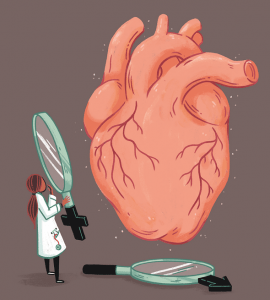Claudia Wallis in Scientific American:
 Consider almost everything you know about heart disease, particularly the garden-variety type involving high cholesterol levels, clogged coronary arteries, stents and bypass surgeries. Now I want you to rebrand all that as “male-pattern” cardiovascular disease. That’s how some researchers are reframing it after taking a closer look at heart disease in women. For years cardiologists were baffled as to why up to half of women with classic symptoms of blocked vessels—chest pain, shortness of breath and an abnormal cardiac stress test—turn out to have open arteries. Doctors called it “cardiac syndrome X.” They didn’t understand it, and many women were subjected to repeated angiograms in search of blockages that weren’t there. That still happens today, but more doctors now recognize that despite having open arteries, about half of women with this pattern nonetheless have ischemia—poor blood flow through the heart. The condition has gained a mouthful of a name: ischemia and no obstructive coronary artery disease, or INOCA.
Consider almost everything you know about heart disease, particularly the garden-variety type involving high cholesterol levels, clogged coronary arteries, stents and bypass surgeries. Now I want you to rebrand all that as “male-pattern” cardiovascular disease. That’s how some researchers are reframing it after taking a closer look at heart disease in women. For years cardiologists were baffled as to why up to half of women with classic symptoms of blocked vessels—chest pain, shortness of breath and an abnormal cardiac stress test—turn out to have open arteries. Doctors called it “cardiac syndrome X.” They didn’t understand it, and many women were subjected to repeated angiograms in search of blockages that weren’t there. That still happens today, but more doctors now recognize that despite having open arteries, about half of women with this pattern nonetheless have ischemia—poor blood flow through the heart. The condition has gained a mouthful of a name: ischemia and no obstructive coronary artery disease, or INOCA.
Cardiologist C. Noel Bairey Merz has spent more than 20 years overseeing the Women’s Ischemia Syndrome Evaluation (WISE) study, aimed at demystifying INOCA and related conditions. Although male-pattern disease is the most prevalent type in both sexes, “INOCA probably comprises 25 to 30 percent of ischemic heart disease in women and 10 percent in men,” says Bairey Merz, director of the Barbra Streisand Women’s Heart Center at Cedars-Sinai’s Smidt Heart Institute. WISE data show that after diagnosis, women with the disorder face a 2.5 percentannual risk of dying, suffering a nonfatal heart attack or stroke, or being hospitalized for heart failure. They are also four times more likely than men to be readmitted to a hospital within 180 days of being treated for a heart attack or severe chest pain.
The initial mystery of INOCA was how the heart could be starving for blood if its main arteries are not blocked.
More here.
